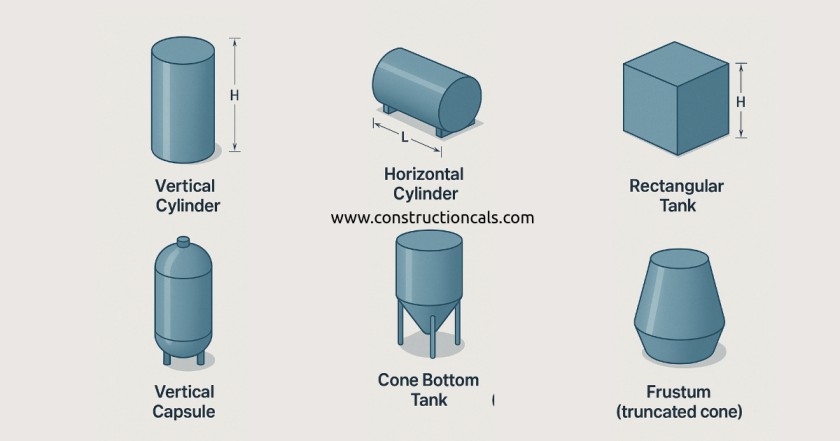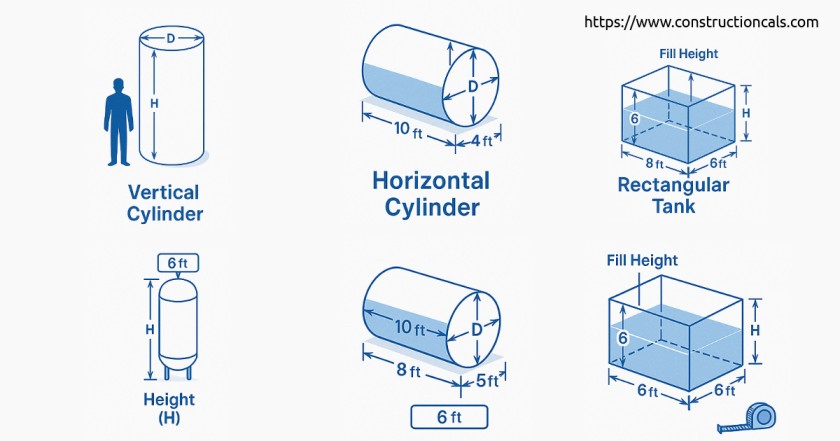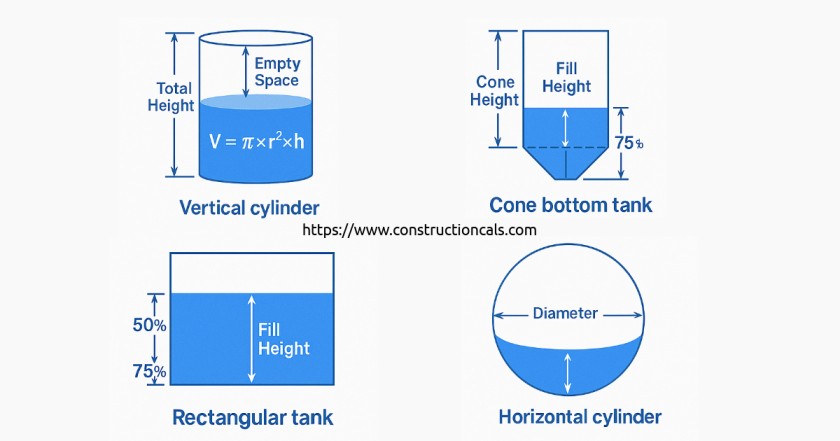Tank Volume Calculator
Last updated: 5/30/2025
Tank Volume Calculator
Last updated: 5/30/2025
Creators
Senior Structural Engineer
Reviewers
Principal Site Engineer & Project Lead
The tank volume calculator helps to quickly calculate the capacity (how much it can hold) of various types of tanks and containers. Whether you are a homeowner planning to set up a rainwater harvesting system, a farmer managing water resources for irrigation, or an engineer designing a storage solution for an industrial project, knowing the volume of your tank is very important for proper planning and resource management.
The capacity of tanks is not just about knowing how much water a tank can hold. It is all about increasing efficiency, managing costs, and ensuring that there is enough storage for your needs.
In addition to the tank volume calculator, we also offer other useful tools such as the Vertical Curve Calculator, Round Pen Calculator, and Miter Angle Calculator. These calculators simplify complex tasks and help ensure precise results for your design and construction projects.
How the Tank Volume Calculator Works
Our tank volume calculator handles 10 different tank shapes:
- Vertical Cylinder
- Horizontal Cylinder
- Rectangular Tank
- Vertical Capsule
- Horizontal Capsule
- Vertical Oval
- Horizontal Oval
- Cone Bottom Tank
- Cone Top Tank
- Truncated Cone (Frustum)
Each shape has a unique volume calculation method. All you need to do is select your tank shape and enter its dimensions. If necessary, you can also specify how high the liquid is currently filled. This will help you determine how much liquid is currently in your tank.
This tank volume calculator calculates and shows both the total capacity of the tank (i.e., the maximum it can be filled) and the volume of liquid currently filled (i.e., how much liquid is in it now). This is very helpful for monitoring how fast materials are being consumed, planning when to refill, and when transferring liquids between tanks.
We use special formulas that take into account the specific geometric shape of each tank. These calculations can sometimes be complex. But our tank volume calculator does these computations for you and provides accurate & best results in your preferred units of measurement.
Common Tank Shapes and Their Volume Formulas

Different tanks are designed for various purposes, with their shapes optimized for specific applications. Here are common tank shapes and their volume formulas:
Vertical Cylinder
The most common tank shape, vertical cylinders are simple to manufacture and efficient for storage. Their volume is calculated as:
Where is the radius (half the diameter) and is the height.
Horizontal Cylinder
Often used for transport or when vertical space is limited, horizontal cylinders require a different approach for calculating partial fill volumes. The total volume formula is:
Where is the length of the cylinder.
Rectangular Tank
Box-shaped tanks maximize space efficiency and are easy to install in corners or against walls. Their volume is simply:
Where is length, is width, and is height.
Specialized Shapes
For more complex geometries like cone-bottom tanks, capsules, or frustums (truncated cones), our calculator implements specialized formulas that accurately determine both total and partial volumes.
Tank Volume Formulas by Shape
Square Tank Volume Formula: For square tanks (which are rectangular tanks with equal length and width): Where is the side length and is the height. This is the same as the rectangular formula where length equals width.
Cylinder Tank Volume Formula: The standard cylinder tank volume formula applies to both vertical and horizontal orientations:
- Vertical cylinder:
- Horizontal cylinder:
Where is radius, is height, and is length.
Converting Tank Dimensions to Gallons: To convert your calculated volume to gallons:
- Cubic feet to gallons: Multiply by 7.48
- Cubic meters to gallons: Multiply by 264.17
- Liters to gallons: Divide by 3.785
Example: A 4ft × 4ft × 6ft rectangular tank = 96 cubic feet = 718 gallons
Practical Considerations for Tank Installation and Usage
When selecting and installing storage tanks, many important things must be considered beyond just empty volume calculations:
Location and access: It's not enough to have space just for the tank. One must also check whether there is enough space for maintenance work, filling operations, and possible future expansion.

Material compatibility: Each liquid requires a different type of tank material. Plastic or concrete tanks are suitable for storing water. But special coated tanks or stainless steel tanks are needed to store chemicals.
Temperature effects: Most liquids expand or contract when the temperature changes. When filling tanks, space for expansion (generally 5-10% of total capacity) should be left.
Pressure considerations: High tanks create more pressure at the bottom. The walls and joints of the tank must be capable of withstanding the maximum pressure that will be present when the tank is completely full.
Support requirements: Large tanks filled with liquid can weigh thousands of kilograms. A proper foundation and structures to support the tank are very essential for safe operation.
FAQs About Tank Volume Calculations
How much water can a 500-gallon tank actually hold?

If a tank is specified to have a capacity of 500 gallons (approximately 1.89 cubic meters), it refers to its total volume. However, in practice, the tank should not be completely filled. To allow for expansion and prevent overflow, it is advisable to leave a 5–10% air gap. Therefore, filling about 450–475 gallons (approximately 1.7–1.8 cubic meters) of water in a 500-gallon tank is sufficient.
What's the best tank shape for limited spaces?
In places where the ground area is limited but height is more, vertical cylindrical or rectangular tanks work well. If the height is limited but there is horizontal space, consider horizontal cylindrical tanks. Regardless of how small the space is, rectangular tanks help make good use of corners, without worrying much about shape. At the same time, cylindrical tanks are structurally stronger with a uniform wall thickness.
How do I calculate how long my water tank will last?
To determine how long your stored water will last:
- Calculate your daily water usage in gallons or liters
- Divide your tank's usable volume by your daily usage
For example, if you have a 1,000-gallon tank and use 50 gallons per day, your supply will last approximately 20 days. Include a safety margin by planning for 80-90% of this calculated duration.
Do I need to account for pipe volume in my calculations?
For most homes and small commercial uses, the volume of liquid in the pipes is very small compared to the tank size. But in large industrial setups with many pipe connections, the liquid in the pipes can be significant. As a general rule, if your pipe system is more than 100 times the diameter of the pipe, the volume of liquid in the pipes should also be considered in your calculation.
How does temperature affect my tank's capacity?
Most liquids expand when heated and contract when cooled. In the case of water, heating from 40°F (approximately 4°C) to 200°F (approximately 93°C) causes about 4% expansion. For fuel oils, expansion can be about 6–7% within the same temperature range. If your tank is likely to experience wide temperature changes, always remember to leave room for expansion.
How do I find out how many gallons are in my tank?
To determine how many gallons your tank holds:
- Measure your tank dimensions (length, width, height for rectangular; diameter and height for cylindrical)
- Calculate volume using the appropriate formula
- Convert to gallons using the conversion factors above
- For current liquid level, measure the liquid height and use our calculator's partial fill feature
What's the easiest volume of tank formula to use?
The easiest volume of tank formula depends on your tank shape:
- Rectangular/Square tanks: Length × Width × Height
- Round tanks: π × radius² × height
- Horizontal cylinders: π × radius² × length
Always measure in consistent units (all feet or all meters) before converting to gallons.
How do I convert tank dimensions to gallons accurately?
Converting tank dimensions to gallons requires two steps:
- Calculate volume in cubic units using the appropriate formula
- Apply the correct conversion factor (1 cubic foot = 7.48 gallons, 1 cubic meter = 264.17 gallons)
Use our calculator above for automatic conversion and to avoid calculation errors.